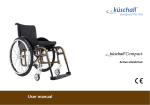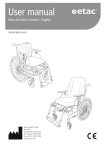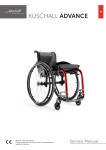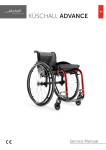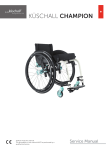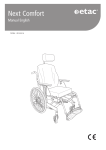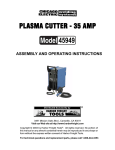Download User manual - Gerald Simonds
Transcript
User manual Cross-folding wheelchairs / English Unfolding Folding • Push one of the seat bars downwards, with your entire hand on top of the seat. • Do not keep hold of the seat bar during unfolding, as there is a risk of trapping your fingers. • Lower the footrests. • Remove/unsnap any bow handle and/or cross-brace, if applicable. • Flip up the footrests. • Lift the seat upwards. Rear wheel with quick release Anti-tip feature 3-4c m A • When assembling, always check that the rear wheel is correctly positioned. • The button in the hub must spring out properly. 3-7 cm • Test how far back you would like the wheelchair to be able to tip. • You must be able to move easily, yet still feel secure. 2 Seat cushion Back cover • Place the back cover far enough back on the seat for a fold to be formed between the backrest and seat. • It is important to always place the back cover on the seat in this way, as it affects user comfort when seated. • Place the cushion far enough back on the seat that the rounded corners are between the back tubes. • Trim the cushion to suit seat depth. • Place any comfort wedge in the pocket of the cover under the cushion. Footrests Calf/Heel strap • Adjust the height until you are sure that your feet are supported and your thighs are resting on the cushion. • Adjust the footrest angle, so the ankles are at 90°. B • Adjust the length so that your insteps rest on the footrests. A • Loosen the lock nut (A) on the legrest fully. Remove the screw (B). Adjust the height. Replace the screw and nut and tighten securely. 3 Backrest angle Back upholstery • Loosen all back straps. • Tighten the strap just below the curve of the back. • Adjust the other straps to allow space for the bottom and follow the natural curve of the back. • The backrest angle may need to be adjusted when adjusting the shape of the back upholstery. Comfort Armrest • Slide the side plate up or down to the required height. • Reattach the screw to the side plate. • Good comfort when seated requires a well-shaped seat that provides: - Pressure distribution. - Stability. - Freedom of movement. • The high position of the armrests supports and relieves pressure on the back better than a lower position. 4 Transfer to/from a wheelchair Sideways From the front • Back the wheelchair up 5-10 cm before stopping so that the castors are facing forwards. • The wheelchair should be close to the transfer point. • Lock the brakes. • Remove/raise the armrest/siderest and legrest on the transfer side. • Back the wheelchair up 5-10 cm so that the castors are facing forwards. • The wheelchair should be close to the transfer point. • Lock the brakes and swivel the legrests in or out under the seat. • Do not stand on the footrests, risk of tipping! Parking Lifting the wheelchair • Increase the support area of the wheelchair by backing up 10 cm so that the castors are facing forwards. • Helper: Lock the brakes and ensure that the anti-tip stabilisers are lowered. • Check that the height-adjustable push handles are properly tightened. • Non-lockable legrests should be swung under the seat, and the wheelchair lifted by the upper front section of the frame. 5 Stairs Kerbs • Always ask for help. • Flip up the anti-tip stabilisers. • Ascending: With the wheelchair facing backwards. • Descending: With the wheelchair facing forwards. • Never use an escalator, even with a helper present. • Flip up the anti-tip stabilisers. • If you are unsure, ask for help. • Up/Low kerb: Back up, take a strong grip and lean your upper body over your thighs. • Down/Low kerb: Back up carefully and lean your upper body over your thighs. Travelling uphill Travelling downhill • Lean your body forwards to correct the centre of gravity. • Lean your body back to correct the centre of gravity. - Check your speed using the handrims, not the brakes! - Always travel up/down as directly as possible. - If you are unsure, ask for help. 6 Vehicle transport Car/taxi Mobility service bus • Ideally, the wheelchair should be placed in the boot. • If the wheelchair is placed in the back seat, ensure that it cannot tip over or roll. Secure it, if possible using the vehicle’s seat belts. Etac’s wheelchairs are crash-tested and approved in accordance with ISO-7176-19 and ISO 10542, with attachment features and three-point belts from Unwin. • The user should transfer to a vehicle seat, if possible, and use the vehicle’s three-point belt during transport. The wheelchair must then be secured so that it cannot tip over or roll. • If the wheelchair is used as a seat when travelling, the chair must be facing in the direction of travel and be fastened to the vehicle at four points, round the end/the front castor mountings and through the transport attachment (item no. 26158) at the back, as shown in the picture. The wheelchair must not be secured through the wheels or round the back tube. • Accessories that can be removed without tools, e.g. trays, must be removed. The wheelchair’s belts are not sufficient to prevent injury in the event of sudden braking. Explanation of symbols Do not lift the chair using the legrests. Do not lift the chair using the armrests. is 1" = 6 kg/cm²/85psi 13/8" =3,5 kg/cm²/50psi Risk of tipping: Always have the anti-tip stabilisers down when moving. Always ensure the tyre pressure correct. Always check the anti-tip stabiliser function when adjusting the seat height, balance position or backrest angle. 7 Maintenance Rear wheels: Clean quick release axles as required. Tyre pressure: Check the tyre pressure, see tyre section (once/month). Castors: Clean castor wheel axles as required. Chassis: Wash with a damp cloth and detergent, e.g. car shampoo. Upholstery: Wash, see labels on each item. In the event of problems, contact your Assistive Equipment Centre. (!) If necessary, lubricate moving parts/joints with cycle oil or similar. Troubleshooting table The wheelchair is pulling diagonally The wheelchair is “heavy” to manoeuvre - Pump up the tyres - Adjust the angle of the front fork mountings - Check that the front fork mountings are fitted at the same height - The rear wheel mountings are incorrectly fitted - The user’s weight is not evenly distributed in the wheelchair - The front handrim is stronger on one side - Pump up the tyres - The rear wheel mountings are incorrectly fitted - Clean any hair and dirt from the castor axles - Too much weight over the castors; adjust the chair’s balance position The wheelchair is awkward to turn - Pump up the tyres - Check that the front forks are not tightened too much - Clean any hair and dirt from the castor axles - Too much weight over the castors; adjust the chair’s balance position The brakes are poor - Pump up the tyres - Adjust the distance between tyre and brake The rear wheels are “loose” - Check that the washer round the hub axle is still in place - Adjust the hub axle length The rear wheels are difficult to get on/off - Lubricate and clean the quick release with cycle oil or similar - Adjust the hub axle length The castors “wobble” - The front forks have not been tightened sufficiently - Check that the front fork mountings are fitted at the same height - Adjust the angle of the front fork mountings - Too much weight over the castors; adjust the chair’s balance position The wheelchair is difficult to fold up/unfold - The upholstery is too taut - Lubricate and clean the cross elements under the seat The wheelchair feels “unsteady” - Pump up the tyres - Check that screws and controls are properly tightened Maximum user weight: Cross/Twin 125 kg, Cross XL 150 kg, Transit 145 kg 74590A 06-06-12 Etac, box 203, se-334 24 Anderstorp TEL +46-371-58 73 00 FAX +46-371-58 73 90 www.etac.com 8









